by Eric Meier
When attempting to identify a wood sample, it’s important to keep in mind the limitations and obstacles that are present in our task. Before starting, please have a look at The Truth Behind Wood Identification to approach the task in a proper mindset; I consider the linked article to be required reading for all those visiting my site with the intent of identifying wood.
1. Confirm it is actually solid wood.
Before proceeding too much farther into the remaining steps, it’s first necessary to confirm that the material in question is actually a solid piece of wood, and not a man-made composite or piece of plastic made to imitate wood.
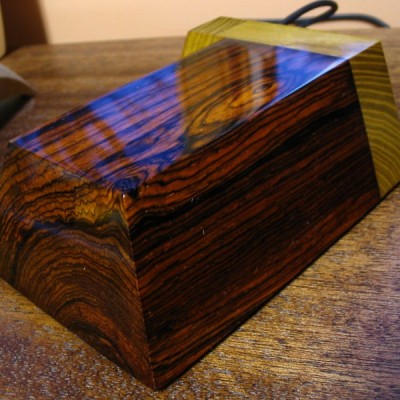
Can you see the end-grain?
Manufactured wood such as MDF, OSB, and particleboard all have a distinct look that is—in nearly all cases—easily distinguishable from the endgrain of real wood. Look for growth rings—formed by the yearly growth of a tree—which will be a dead-giveaway that the wood sample in question is a solid, genuine chunk of wood taken from a tree.
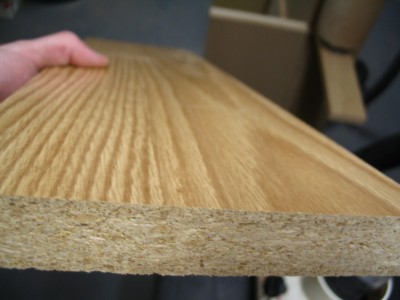
Is it veneered?
If you see a large panel that has a repeating grain pattern, it may be a veneer. In such cases, a very thin layer of real wood is peeled from a tree and attached to a substrate; sometimes the veneer can be one continuous repeating piece because it is rotary-sliced to shave off the veneer layer as the tree trunk is spun by machines. Assuming it is a real wood veneer with a distinct grain and texture—and not merely a piece of printed plastic—you may still be able to identify the outer veneer wood in question, but you should still realize that is it only a veneer and not a solid piece of wood.
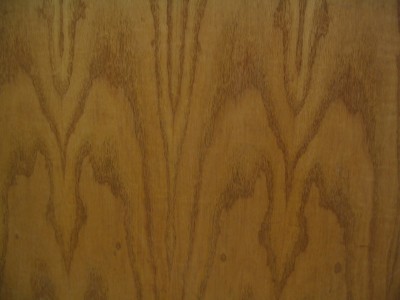
Is it painted or printed to look like wood?
Many times, especially on medium to large-sized flat panels for furniture, a piece of particleboard or MDF is either laminated with a piece of wood-colored plastic, or simply painted to look like wood grain. Many of today’s interior hardwood flooring planks are good examples of these pseudo-wood products: they are essentially a man-made material made of sawdust, glues, resins, and durable plastics.
2. Look at the color.
Some questions to immediately ask yourself:
Is the color of the wood natural, or is it stained?
If there is even a chance that the color isn’t natural, the odds are increased that the entire effort of identifying the wood will be in vain.
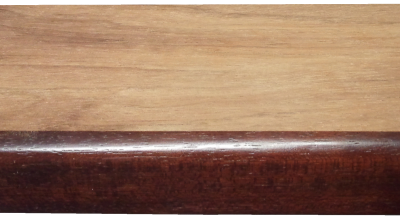
Is it weathered or have a patina?
Many woods, when left outside in the elements, tend to turn a bland gray color. Also, even interior wood also takes on a patina as it ages: some woods get darker, or redder, and some even get lighter or lose their color; but for the most part, wood tends to darken with age.
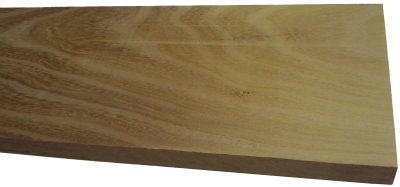
Is it possible to sand or plane the board to see the natural raw color of the wood?
The most predictable baseline to use when identifying wood is in a freshly sanded state. This eliminates the chances of a stain or natural aging skewing the color diagnosis of the wood.
3. Observe the wood grain.
If the wood is unfinished, then look at the texture of the grain. Ask yourself these questions:
Does the wood have an open, porous texture?
Most softwoods will be almost perfectly smooth with no grain indentations, while many common hardwoods have an open pore structure, such as oak or mahogany; though there are some hardwoods that are also smooth to the touch, such as maple.
Can you tell if the wood is quartersawn or plainsawn?
By observing the grain patterns, many times you can tell how the board was cut from the tree. Some wood species have dramatically different grain patterns from plainsawn to quartersawn surfaces. For instance, on their quartersawn surfaces, lacewood has large lace patterns, oak has flecks, and maple has the characteristic “butcher block” appearance.
Is there any figure or unusual characteristics, such as sapwood, curly or wild grain, burl/knots, etc.?
Some species of wood have figure that is much more common than in other species: for example, curly figure is fairly common in soft maple, and the curls are usually well-pronounced and close together. Yet when birch or cherry has a curly grain, it is more often much less pronounced, and the curls are spaced farther apart.
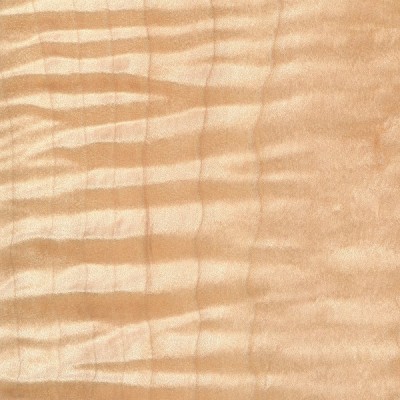
4. Consider the weight and hardness of the wood.
If it’s possible, pick the piece of wood up and get a sense of its weight, and compare it to other known wood species. Try gouging the edge with your fingernail to get a sense of its hardness. If you have a scale, you can take measurements of the length, width, and thickness of the wood, and combine them to find the density of the wood. This can be helpful to compare to other density readings found in the database. When examining the wood in question, compare it to other known wood species, and ask yourself these questions:
Is the wood dry?
Wood from freshly felled trees, or wood that has been stored in an extremely humid environment will have very high moisture contents. In some freshly sawn pieces, moisture could account for over half of the wood’s total weight! Likewise, wood that has been stored in extremely dry conditions of less than 25% relative humidity will most likely feel lighter than average.
How does the wood’s weight compare to other species?
Taking into account the size of the board, how does its weight compare to other benchmark woods? Is it heavier than oak? Is it lighter than pine? Look at the weight numbers for a few wood species that are close to yours, and get a ballpark estimate of its weight.
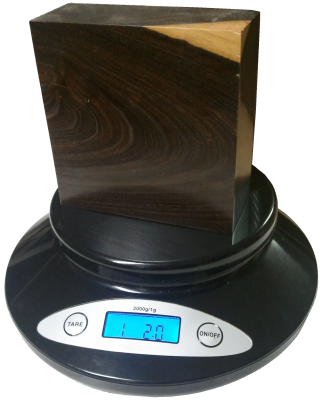
How hard is the wood?
Obviously softwoods will tend to be softer than hardwoods, but try to get a sense of how it compares to other known woods. Density and hardness are closely related, so if the wood is heavy, it will most likely be hard too. If the wood is a part of a finished item that you can’t adequately weigh, you might be able to test the hardness by gouging it in an inconspicuous area. Also, if it is used in a piece of furniture, such as a tabletop, a general idea of its hardness can be assessed by the number and depth of the gouges/dings in the piece given its age and use. A tabletop made of pine will have much deeper dents than a tabletop made of Oak. Additionally, you can always try the “fingernail test” as a rough hardness indicator: find a crisp edge of the wood, and with your fingernail try to push in as hard as you can and see if you’re able to make a dent in the wood.
5. Consider its history.
Many times we forget common sense and logic when attempting to identify wood. If you’ve got a piece of Amish furniture from Pennsylvania, chances are more likely that the wood will be made of something like black walnut or cherry, and not African wenge or jatoba. You might call it “wood profiling,” but sometimes it can pay to be a little prejudiced when it comes to wood identification. Some common-sense questions to ask yourself when trying to identify a piece of wood:
Where did it come from?
Knowing as much as you can about the source of the wood—even the smallest details—can be helpful. If the wood came from a wood pile or a lumber mill where all the pieces were from trees processed locally, then the potential species are immediately limited. If the wood came from a builder of antique furniture, or a boat-builder, or a trim carpenter: each of these occupations will tend to use certain species of woods much more often than others, making a logical guess much simpler.
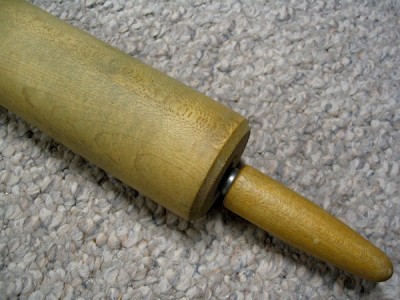
How old is it?
As with the wood’s source, its age will also help in identification purposes. Not only will it help to determine if the wood should have developed a natural patina, but it will also suggest certain species which were more prevalent at different times in history. For instance, many acoustic guitars made before the 1990s have featured Brazilian rosewood backs/sides, yet due to CITES restrictions placed upon that species, East Indian rosewood became a much more common species on newer guitars. (And this is a continuing shift as newer replacements are sought for rosewoods altogether.)
How large is the piece of wood?
Some species of trees are typically very small—some are even considered shrubs—while others get quite large. For instance, if you see a large panel or section of wood that’s entirely black, chances are it’s either painted, dyed, or stained: Gaboon ebony and related species are typically very small and very expensive.
What is the wood’s intended use?
Simply knowing what the wood was intended for—when considered in conjunction with where it came from and how old it is—can give you many clues to help identify it. In some applications, certain wood species are used much more frequently than others, so that you can make an educated guess as to the species of the wood based upon the application where it was used. For instance, in the United States: many older houses with solid hardwood floors have commonly used either red oak or hard maple; many antique furniture pieces have featured quartersawn white oak; many violins have spruce tops; many closet items used aromatic red cedar, and so forth. While it’s not a 100% guarantee, “profiling” the wood in question will help reduce the number of possible suspects, and aid in deducing the correct species.
6. Find the X-Factor.
Sometimes, after all the normal characteristics of a sample have been considered, the identity of the wood in question is still not apparent. In these instances—particularly in situations where a sample has been narrowed down to only a few possible remaining choices—it’s sometimes helpful to bring in specialized tests and other narrower means of identification.
The following techniques and recommendations don’t necessarily have a wide application in initially sorting out wood species and eliminating large swaths of wood species, but will most likely be of use only as a final step in special identification circumstances.
Odor
Believe it or not, freshly machined wood can have a very identifiable scent. When your eyes and hands can’t quite get a definitive answer, sometimes your nose can. Assuming there is no stain, finish, or preservative on or in the wood, quickly sand, saw, or otherwise machine a section of the wood in question, and take a whiff of the aroma.
Although new scents can be very difficult to express in words, many times the scent of an unknown wood may be similar to other known scents. For instance, rosewoods (Dalbergia spp.) are so named for their characteristic odor that is reminiscent of roses. Although difficult to directly communicate, with enough firsthand experience scents can become a memorable and powerful means of wood identification.
Fluorescence
While certain woods can appear basically identical to one another under normal lighting conditions, when exposed to certain wavelengths—such as those found in blacklights—the wood will absorb and emit light in a different (visible) wavelength. This phenomenon is known as fluorescence, and certain woods can be distinguished by the presence or absence of their fluorescent qualities. See the article Fluorescence: A Secret Weapon in Wood Identification for more information.
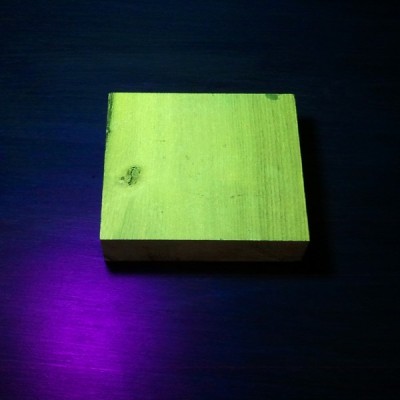
Chemical Testing
There are only a small number of chemical tests regularly used on wood, most of which are very specialized and were developed to help distinguish easily confused species with one another. They work by detecting differences in the composition of heartwood extractives. A chemical substance (called a reagent) is usually dissolved in water and applied to the wood surface: the surface is then observed for any type of chemical reaction (and accompanying color change) that may occur. Two of the most useful are the tests that are meant to separate Red and White Oak, and Red and Hard Maple.
Heartwood Extractives Leachability
Sometimes a wood species will have heartwood extractives that will be readily leachable in water and capable of conspicuously tinting a solution of water a specific color. For instance, the heartwood extractives contained in osage orange (Maclura pomifera) contain a yellowish-brown dye that is soluble in water. (This can sometimes be observed anecdotally when the wood is glued with a water-based adhesive: the glue’s squeeze-out is an unusually vibrant yellow.)
In a simple water extract color test, wood shavings are mixed with water in a vial, test tube, or other suitably small container, and the color of the water is observed after a few minutes. If the heartwood extractives are leachable by water, then a corresponding color change should quickly occur.
In addition to osage orange (Maclura pomifera), merbau (Intsia spp.), and rengas (Gluta spp. and Melanorrhoea spp.) are also noted for their readily leachable heartwood extractives. Because this property is quite uncommon, it can serve to quickly differentiate these woods from other lookalikes.
7. Look at the endgrain.
Perhaps no other technique for accurate identification of wood is as helpful and conclusive as the magnified examination of the endgrain. Frequently, it brings the identification process from a mostly intuitive, unscientific process into a predictable, repeatable, and reliable procedure.
Looking at the endgrain with a magnifier shouldn’t be a mystifying or esoteric art. In many cases, it’s nearly as simple as examining small newsprint under a magnifying glass. There are three components necessary to reap the full benefits contained in the endgrain:
I. A prepared surface.
When working with wood in most capacities, it becomes quickly apparent that endgrain surfaces are not nearly as cooperative or as easily worked as face grain surfaces. However, in this case, it is absolutely critical that a clear and refined endgrain surface is obtained.
For a quick glance of a softwood sample, a very sharp knife or razor blade can be used to take a fresh slice from the endgrain. However, in many denser species, especially in tropical hardwoods, one of the best ways to obtain a clear endgrain view is through diligent sanding. It’s usually best to begin with a relatively smooth saw cut (as from a fine-toothed miter saw blade) and proceed through the grits, starting at around 100, and working up to at least 220 or 320 grit, preferably higher for the cleanest view.
II. The right magnifier.
It need not be expensive, but whatever tool is used to view the endgrain should have adequate magnifying power. In most instances, 10x magnification is ideal, however, anything within the range of 8 to 15x magnification should be suitable for endgrain viewing. (Standard magnifying glasses are typically in the range of 2 to 4x magnification.)
These stronger magnifiers, sometimes called loupes, usually have a smaller viewing area than standard magnifying glasses. Fancier models—with built in lights, or larger viewing surfaces—are available at a premium; but the most basic models are usually only a few dollars.
III. A trained eye.
The third element that constitutes a proper endgrain examination is simply knowing what to look for. In analyzing the patterns, colors, shapes, and spacing of the various anatomical features, there is a veritable storehouse of information within the endgrain—all waiting to be unlocked. Yet, if these elements have not been pointed out and learned, the array of features will simply seem like an unintelligible jumble. The discipline of recognizing anatomical endgrain features is not easily summed up in a few sentences or even a few paragraphs, but it is nonetheless critical to the identification process. To this end, an in-depth look should be given to the various categories, divisions, and elements that constitute endgrain wood identification on the macroscopic level. (In this regard, macroscopic denotes what can be seen with a low-powered, 10x hand lens—without the aid of a microscope—rather than simply what can be seen with the naked eye.) Because the anatomy between softwoods and hardwoods is so divergent, each will be considered and examined separately:Still stumped?
If you have a mysterious piece of wood that you’d like identified, you’ve got a few options for next steps:USDA’s Forest Products Laboratory
You can mail your physical wood samples to the Center for Wood Anatomy Research.
Pros:
- Free
- Professional wood identification
Cons:
- Only available to US citizens
- Slow turnaround times (up to a month or more)
- Limited to three IDs per year
See their Wood ID Factsheet for more info.
Alden Identification Service
You can mail your physical wood samples (even small sections taken from antiques) to Alden Identification Service.
Pros:
- Professional wood identification
- Faster turnaround times (ranging from a few days to a week or two)
Cons:
- Paid service
See their ordering page for more info. (Note that Harry Alden has written several books while at USDA, including both Hardwoods and Softwoods of North America.)
Ask for help online
If the wood ID is merely a curiosity, or non-critical, you can post pictures of the wood in question.
Pros:
- Free
- No need to send physical samples
Cons:
- Greatly limited by the quality of the pictures provided
- Extra work usually required to get adequate clarity in photos
See article of Common US Hardwoods to help find the most commonly used woods.
Get the hard copy
 If you’re interested in getting all that makes The Wood Database unique distilled into a single, real-world resource, there’s the book that’s based on the website—the Amazon.com best-seller, WOOD! Identifying and Using Hundreds of Woods Worldwide. It contains many of the most popular articles found on this website, as well as hundreds of wood profiles—laid out with the same clarity and convenience of the website—packaged in a shop-friendly hardcover book.
If you’re interested in getting all that makes The Wood Database unique distilled into a single, real-world resource, there’s the book that’s based on the website—the Amazon.com best-seller, WOOD! Identifying and Using Hundreds of Woods Worldwide. It contains many of the most popular articles found on this website, as well as hundreds of wood profiles—laid out with the same clarity and convenience of the website—packaged in a shop-friendly hardcover book. 





Why I will no longer be replying to every wood ID request I’ve replied to literally thousands of wood ID requests on this site over the past 13+ years, but as the site’s popularity has grown, so has the time demands for ID on a daily basis. (Contrary to what some may seem to think, I am not some all-knowing wood wizard that can instantly ID your wood. It can actually take me a long time to sift through a lot of different resources.) Over the past few years, my backlog of pending wood species to be added to the… Read more »
Can anyone identify this type(s) of wood in this table and stools? I brought this set 25 years ago and don’t know its history. Now I am trying to describe it in order to try and sell it. Thanks in advance for your expertise!
Sure looks like Beech to me.
Can anyone tell me what this wood is ? It’s a very thick veneer, front and back.
Hi, I just purchased this table on eBay and the lady selling it could not remember what type of wood it was. I took pictures of stained and polished side and the underside that was left raw.
I would appreciate any help.
Kind Regards
Ok. as I’ve failed to submit photos last time I’ll try again. Its collor is a pinkish red and a tint lighter than padouk. I’ve included a piece of walnut for comparison. Thank you in advance.
Looks like a Pterocarpus spp. to me (i.e., some type of Padauk). There can be a lot of color variation with Padauk. I remember one vender even sold what was called “bacon” padauk, which looked, quite honestly, like strips of bacon.
Thank you ejmeier. It should be mouth watering.
It’s a pity though, my sample is too soft for micro work. I was planning to carve a cufflink with it.
Hi. Can you identify this wood. Its collor is a pinkish red and a tint lighter than padouk. I’ve included a piece of walnut for comparison. Thank you in advance
A customer wanted wood and stain to match this photo. Any thoughts?
Looks like birch plywood stained with a dark red mahogany stain.
My aunt bought a curio cabinet about 20 years ago and lost her paperwork. She asked me to help her id the wood. It sounds like a solid like wood when I tap and knock on the panels, but not a heavy “thunk” like when you knock on particleboard. Any ideas?
The wood has been stained, and appears to be either a softwood like pine, or possibly birch.
Thank you
Hello was wondering if anybody could please identify these wood pieces. They are very hard and heavy. No smell and are completely dry.
I would not really classify true mahogany as being VERY hard or heavy: it’s moderate weight and ease of sanding/working is actually appreciated. I can’t tell from the rough surfaces of those pics. If possible, plane/sand the surfaces, and ideally, get a finely sanded shot of the endgrain.
Thanks for responding, here are some sanded pics of the end grain (wet and dry) and top of piece. This particular piece has a two tone color to it. Thinking about the weight, I compared it to a piece of maple of similar dimension and the maple was a lot heavier. Upon sanding, it was easier than I thought it would be. Thanks again for any more insight.
DOES ANYONE KNOW WHAT TYPE OF WOOD THIS IS?
More than likely a rotary cut softwood veneer, possibly Douglas Fir or Larch.
This is an old wooden box, but I just can’t pick the wood. It’s been grossly over glossed and I’d love tho sand it back to it’s original colour. Any ideas on what it could be? I’d be very appreciative if anyone could help! My Dad seems to think it’s pine, but I’m not sure.
Are you referring to the wood in the upper left of the picture? It looks like quartersawn White Oak. That stain and appearance is characteristic of many antiques, and while I am generally opposed to staining wood in most instances, if you stripped it down to bare wood and refinished it a natural color, you may regret it. If the finish itself isn’t in the best shape, there’s other things you can do to refinish that doesn’t involve sanding down to bare wood and removing the stain.
Yes, I am :) It was made in Australia, but I’m not sure if get white oak out here? I can’t stand the hi-gloss finish and the lighter wood you can see on the inside is in it’s natural state. What would you recommend to refinish it? Cheers!
Having trouble identifying these 2 pieces- Any ideas?
The First Pic is a headboard built in the 70s and the second is a table built in the 60’s
First one looks like a type of mahogany. Second one is very nondescript, so I can’t really tell from that picture.
HiI have this large deer carved . The wood is suppose to be fro Africa Can anyone id it .
Looks like a species of Red Palm to me.
Can someone identify what type of wood this is?
https://imgur.com/a/pNLin
Very hard to tell from those pictures. Overall it almost looks like a softwood, but the rippled grain surrounding the knot reminds me of a fine-grained hardwood. Possibly birch?
Identify this wood
Can’t tell from that pic, sorry.
looks like pine
Can anyone tell what kind of wood might this be? I cut out this little piece from a painted board (the piece you see in the pics isn’t painted nor anything else). I had the original board from a friend of mine who told me that was IROKO. However he wasn’t sure about it. It seems hard and solid, but it gets scratches quite easily (and that’s why I’m still not sure it is iroko). It’s light as well. If it’s iroko (or some other very hard wood) I’m gonna use it to make the fretboard of a ukulele, as… Read more »
I agree it could be Iroko. Unfortunately, we’d need to see a clear, sanded, closeup shot of the endgrain to have a better chance at an ID.
would love some help identifying this wood. Its the top of a Jackson Desks desk from somewhere around the 50’s or 60’s. It is solid wood, sanded to bare wood and is solid. It has only mineral spirits on the bare wood to see the grain.
Where are you located? Where do you believe this table originated from, geographically? Any noticeable scent when sanding it?
I’m in NH and the desk was built in Jasper, IN. I can’t say for sure about a smell. Its a fair hard wood. A hard birch maybe but it has a nice natural reddish color. The top wasn’t in bad condition when I got it.
If I had to limit my guesses to hardwoods that would be common to furniture makers in that area and time. I would say Black Cherry.
I think you’re right. I’ve never really seen such a curly cherry. I have
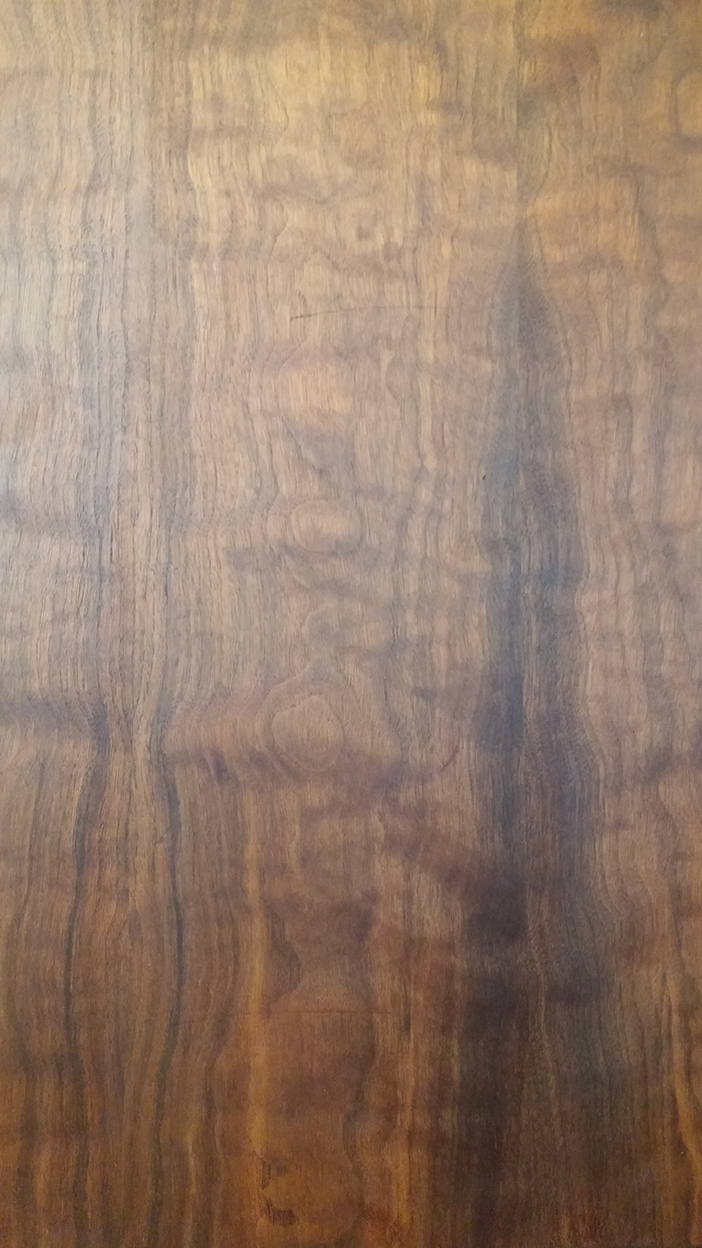
one more closeup of the grain. Thanks for your help!
I’ve seen curly cherry, and it tends to have broad waves like in your picture, not the tight 3D ripples that’s so common in maple.
It’s oak, quarter sawn
Pine? =)
Definitely a softwood. Based on your location, my first guess would be Douglas Fir.
What type of wood is this slab. I was told this is Maple is it true? i am getting second thoughts as i see wide heart wood in middle. These slabs are 22″ wide to get guess.
From a casual glance at a distance, I agree that it looks like maple. Only a very clear and in focus closeup of the endgrain would help to confirm this.
Thanks ejmeir. I was getting second thoughts as the darker heartwood.
This is 4 pieces glued together then turned but im still not sure what it is…? It is a Bitc* to work with and this is unfinished. Please help!
Looks like Red Palm, and the low quality stuff found closer to the center of the “trunk.”
Can anyone tell me what kind of wood this is? It is the flooring in a home I just purchased. Thanks
Looks like a softwood to me. Douglas fir or larch are the first species to come to mind.
anyone know what type of wood this is? its made in italy and at least 30 years old
Well, the overall color appears walnut-like. But it’s impossible to tell for sure from that distance.
Hi, I just stripped and sanded down this trim. There’s much more of it, but I thought this was a good close-up. Does this look like Oak to you? That was my guess, but I am certainly not a professional.
Can anyone tell me what kind of wood this is from this picture. I was told this is an antique set and solid wood but doesn’t know the kind of wood. Thank you.
hello i have a piece of wood id like someone to indentify…thanks in advance
We just stripped the paint off this old table – I don’t really have access to the end grain since it’s all one piece… I’m just looking for best bet, but am I looking at maple perhaps? The table appears to have had some wear and tear, so we’re trying to decide what type of stain we can go with to hide some of it. I am almost positive the main top and bottom of the table is solid and real wood, it’s thick, heavy, and the grain seems to go all the way through. What I can’t figure out… Read more »
Not Maple. Looks like a ring porous hardwood like ash, or possibly oak. That edge deterioration looks very fishy. Sanding should definitely IMPROVE the look, not damage it further. If that’s the case, then I would be inclined to think that the entire tabletop pattern is fake. Stuff that’s fake is also very heavy and thick, as the MDF/particleboard substrate is naturally heavy (and cheap). You might as well go to town with the sander in hopes of getting a clean wood surface. If it turns out to be real wood, you’ll have a clean surface to work with. If… Read more »
This is pallet wood. Anyone what kind it is? Thanks
Looks like a softwood of some sort. Maybe Douglas fir? Practically impossible to say with any degree of certainty without seeing the endgrain up close (and sanded).
Thanks ejmeeir :)
I bought this in South Africa over 20 years ago. I do not know what kind of wood it is. I an not sure if it is to scoop water, or if it is used to hold bananas.
Definitely looks like a softwood. Not sure what types of softwoods are commonly used in South Africa; maybe someone more familiar with the area can chime in?
Does anyone have a clue what this diamond shaped piece is? I’ve searched all over the internet, contacted about 6 different veneer suppliers, and can’t seem to figure it out!! Please help!
Looks tough to ID. It’s sort of a nondescript light colored wood. It looks close to maple, but I suspect it isn’t: it looks like the pores are larger than maple in the left corner of the diamond. It’s also tough since it doesn’t look like a strong burl, but it’s also not typical clear wood either; it’s sort of in a no-man’s land where it’s knotty, figured, but not a tightly figured burl. The color and grain look vaguely reminiscent of myrtle to me, not myrtle burl, just figured myrtle, but that’s a very wild guess. The reddish brown… Read more »
Oh well, thanks for trying! I may have just replace the whole table since I can’t find a match anywhere.
Just wondering if anyone can identify the timber used in this bench? Probably a simple answer! thanks
I was able to resize 2 other pics regarding my last post in hopes of identifying the species of wood these timbers are.
Need to see an clear, sanded, closeup view of the endgrain. (Or at the very least, a planed or surfaced side of one of the beams.
I don’t have means of doing so however I can crosscut one of the ends if you think that will help? I’m not a wood worker so I don’t have the tools most people would have i.e. surface planer, etc…
I have these beams that are extremely dense and weigh a ton! Can anyone take a guess to help me identify what species of wood they are? They are rough sawn timbers sealed in a wax color and the wood is black in color. My neighbor’s deceased husband was a woodworker and he worked with various types of species. She had about a dozen of these 4′ high timbers she was going to get rid of and I decided to take them. Each one weighs approximately 50 lbs or better. I have more pics but google is being difficult and… Read more »
Hello, I found this nice piece of wood lying on my roof and was wondering if anyone could help me identify it? I figure it might be ash or oak. (Sorry but couldn’t resist playing around and finishing it. Although I trust the grain is fairly clear.)
More than likely not a hardwood, but a softwood like southern yellow pine or douglas fir. You can tell because softwoods always absorb dyes differently than hardwoods — basically, the latewood zone that creates the annual growth rings in softwoods doesn’t absorb much dye, so it appears lighter after dyeing. The softer and more open earlywood absorbs a lot more dye and looks darker, so basically the light-dark growth ring patterns of softwoods get inverted when dyed. In ring-porous hardwoods like oak or ash, the opposite is true.
Hello there. Here’s an old mirror that used to be part of a dressing table. I’m trying to identify the wood, and would be grateful for any information.
Hard to tell from those pictures. Also hard to tell if that’s the natural wood color, or if it has been stained that color. Where are you located? It appears to be a hardwood with very large pores. If you were located in the United States, I would guess ash or oak, but it could be any number of species, perhaps even teak. Without access to the endgrain, it’d be very hard for me to say for sure.
Thanks, yes. It is a diffuse poroous hardwood. Looks like maple to me.
Been reading some of the comments so was hoping someone may be able to help me identify this wood. The 2 poctures here are the wood unsanded.
Not sure why it appears the colors are so different between pictures, but the second one looks similar to walnut. A clear, sanded, closeup shot of the endgrain would help a lot.
Can anyone tell me what kind of wood this is? I believe it’s a type of mahogany. It’s from an old Chippendale table.
Yes, I agree that it certainly does look like a mahogany. Have you seen my article on mahogany types? https://www.wood-database.com/wood-articles/mahogany-mixups-the-lowdown/
wanting to stain an old chair, but i’m not sure what kind of wood it is…any ideas? sanded a bit of the old surface off to show the grain
Where are you located? My initial guess would be birch, though it may be any number of diffuse porous hardwoods, such as maple. The endgrain picture is so grainy, it’s hard to tell if its even a softwood or a hardwood.
We’re trying to sell off some inherited furniture of unknown provenance and would greatly appreciate help identifying the type of wood used to build this table. Cheers!
It’d be very hard to get a positive ID from just those pictures, but my best guess, from a North American perspective, would be White Oak. That’s based on color, porosity, and the ray size.
Hi, I was hoping you may be able to tell me what kind of pine this is..?? It was from pallets to hold large spools of shipped wire coils….??
Nice tight grain like a cedar, but varied colouring… Quite fluffy, also… and very light weight…
Is it a spruce pine..?? Thank you in advance… :)
The only way to really get a good ID for softwoods is to get a clear, finely-sanded, closeup shot of the endgrain, and look for resin canals. https://www.wood-database.com/wood-articles/softwood-anatomy/
Does this help any..??
No, sorry. Those are very rough cuts, so I can’t make out much detail. That middle one has knots and abnormal grain too, so it might not be the best section to look at.
Hello All,
We recently purchased a acreage. In the barn I found roughly twelve board cut by I’m guessing to be a turn of the century saw mill(really rough circular cuts). I know its a hard wood, good weight to it. If i had to guess, I would say its red oak. Can anyone confirm?
Although I always hesitate to attempt an ID from a single face grain shot, that sure does look like Black Walnut to me. That’s my best guess given the limited information.
Can you help me identify this wood?
Can’t tell from that distance. Assuming that all the pieces are the same species, getting a finely sanded, in-focus endgrain closeup might help with ID.
i see no one know what kind of wood this might be ,, so i assume its pine
Good Day, Can anyone kindly identify what kind of wood (American Chestnut?) these old beams might be based on the pictures below. Thank you for your assistance in solving this mystery for me!
Very hard to tell from those pictures. If I had to guess based on that one tiny exposed section, I’d say it probably wasn’t chestnut. If you can get a clear, sanded closeup shot of the endgrain, that would help a lot.
So I took your suggestion and sanded the endgrain in hopes that you would be able to help identify what specific kind of wood I have here! Thanks for your assistance!!
Definitely a softwood, and not chestnut. What location are you from, and where are these beams from? Any noticeable scent when sanding them?
It’s still hard to tell since those pictures are thumbnails, and not the full-sized originals. Basically, the most important feature in softwood ID is to see if there are resin canals: https://www.wood-database.com/wood-articles/softwood-anatomy/
Great blog/database! Thanks. I wonder if you can help identify a guitar wood. The guitar is in pieces, but I have broken bits that I’d like to replace. Inside I am not so concerned, but I’d like to replace both sides with as similar a wood as possible. My guess is mahogany, but I’d like to be sure before searching out the replacement wood. The guitar is from the 1920’s and was made in California which might help limit the possibilities. I’ve attached pictures of a broken edge, rough quarter-sawn interior side, smooth, unfinished exterior, and a broken end. Discoloration… Read more »
I agree it looks like mahogany. Can’t be sure without a clearer endgrain view, but it seems like a good educated guess. Probably Swietenia spp like Hondruan or Cuban, and not Khaya spp. i.e., African.
Hi can anyone tell me what type of wood this is? also markings if anyone has seen it.
thanks
Sorry just wondering if anyone knows what type of wood this table might be? Looks pretty and might want to buy it, is it worth it to buy?
Can anyone tell me what wood this is?
Can’t tell, sorry. Where are you located, and do you have any shots closer up?
Hello folks, any idea what kind of wood can be that?
Do you have any more pics? Hard to tell from that one image.
Hello folks, any idea what kind of wood can be that?